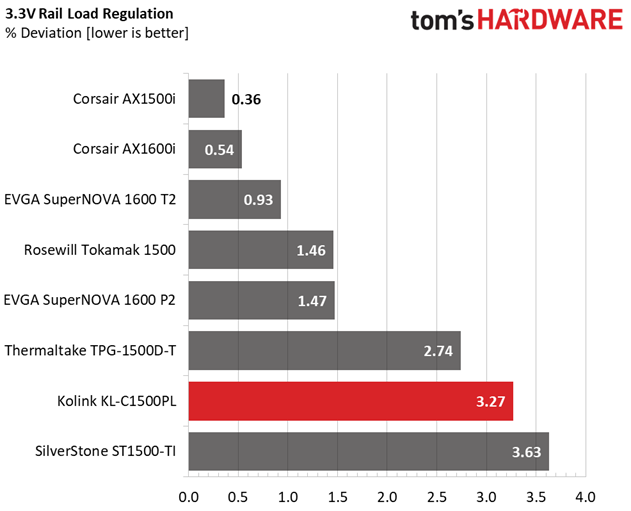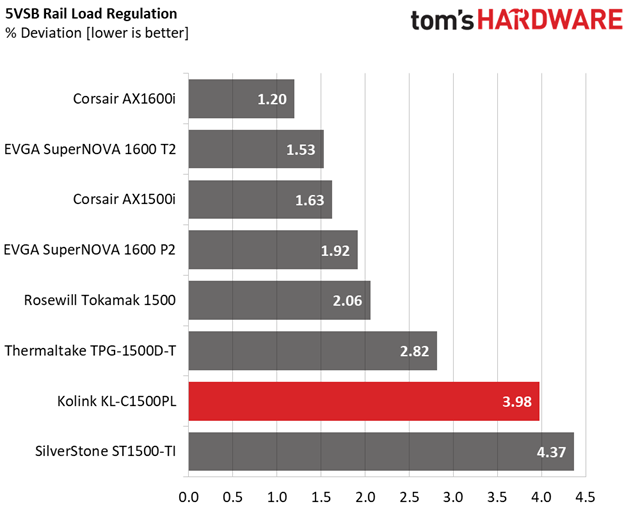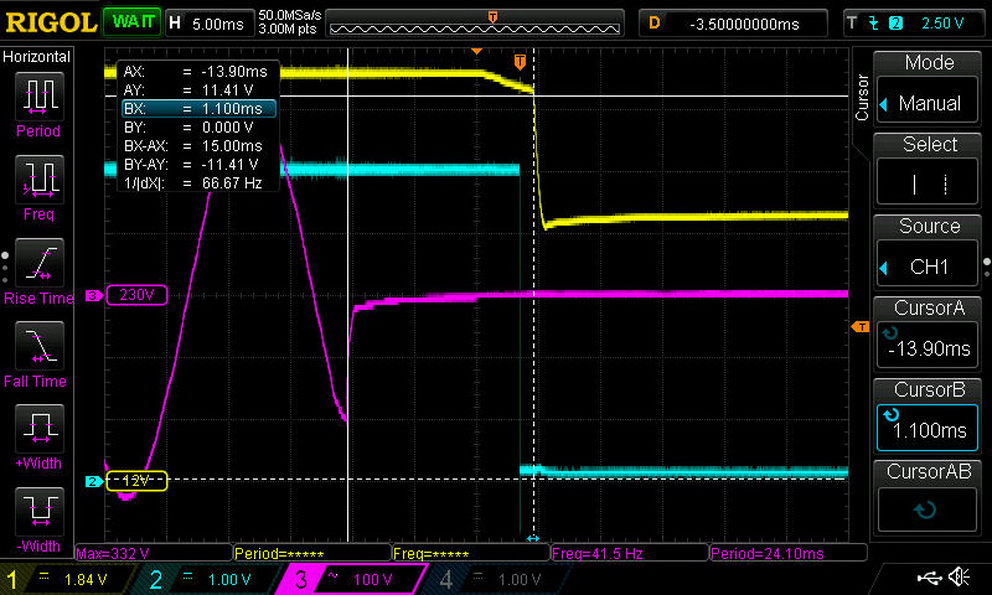Kolink Continuum KL-C1500PL PSU Review: Miner's Delight?
Why you can trust Tom's Hardware
Load Regulation, Hold-Up Time & Inrush Current
To learn more about our PSU tests and methodology, please check out How We Test Power Supply Units.
Primary Rails And 5VSB Load Regulation
Load Regulation testing is detailed here.








Hold-Up Time
Our hold-up time tests are described in detail here.







Neither the hold-up time nor the power-good signal satisfy the ATX spec's requirements. At least the power-good signal is accurate. You should avoid any PSU that reports this signal falsely; it'll apply a lot of stress to your system's components any time power is lost.
Inrush Current
For details on our inrush current testing, please click here.


For such a high-capacity PSU, the inrush current is pretty low with both voltage inputs.
Load Regulation And Efficiency Measurements
The first set of tests reveals the stability of the voltage rails and the KL-C1500PL's efficiency. The applied load equals (approximately) 10 to 110 percent of the PSU's maximum load in increments of 10 percentage points.
Get Tom's Hardware's best news and in-depth reviews, straight to your inbox.
We conducted two additional tests. During the first, we stressed the two minor rails (5V and 3.3V) with a high load, while the load at +12V was only 0.1A. This test reveals whether a PSU is compatible with Intel's C6/C7 sleep states or not. In the second test, we determined the maximum load the +12V rail could handle with minimal load on the minor rails.
| Test # | 12V | 5V | 3.3V | 5VSB | DC/AC (Watts) | Efficiency | Fan Speed | PSU Noise | Temps (In/Out) | PF/AC Volts |
|---|---|---|---|---|---|---|---|---|---|---|
| 1 | 10.486A | 1.969A | 1.984A | 0.983A | 149.517 | 87.838% | 0 RPM | <6.0 dB(A) | 44.64°C | 0.977 |
| 12.199V | 5.077V | 3.325V | 5.090V | 170.219 | 37.96°C | 115.77V | ||||
| 2 | 22.065A | 2.961A | 2.988A | 1.183A | 299.648 | 90.432% | 1155 RPM | 31.8 dB(A) | 38.57°C | 0.981 |
| 12.180V | 5.065V | 3.312V | 5.074V | 331.353 | 45.60°C | 115.56V | ||||
| 3 | 34.012A | 3.461A | 3.481A | 1.384A | 449.611 | 91.215% | 1390 RPM | 36.8 dB(A) | 39.13°C | 0.988 |
| 12.161V | 5.056V | 3.302V | 5.057V | 492.912 | 46.44°C | 115.46V | ||||
| 4 | 45.957A | 3.963A | 4.007A | 1.587A | 599.661 | 92.144% | 1442 RPM | 38.1 dB(A) | 39.37°C | 0.980 |
| 12.152V | 5.047V | 3.292V | 5.040V | 650.786 | 46.90°C | 115.36V | ||||
| 5 | 57.635A | 4.964A | 5.030A | 1.792A | 749.841 | 91.721% | 1843 RPM | 43.3 dB(A) | 39.88°C | 0.982 |
| 12.134V | 5.036V | 3.280V | 5.023V | 817.522 | 47.70°C | 115.15V | ||||
| 6 | 69.327A | 5.971A | 6.060A | 1.998A | 899.916 | 91.214% | 2160 RPM | 46.9 dB(A) | 40.98°C | 0.986 |
| 12.118V | 5.025V | 3.268V | 5.006V | 986.595 | 49.18°C | 115.02V | ||||
| 7 | 81.029A | 6.981A | 7.096A | 2.205A | 1050.045 | 90.695% | 2310 RPM | 49.5 dB(A) | 42.16°C | 0.990 |
| 12.106V | 5.014V | 3.256V | 4.989V | 1157.776 | 50.52°C | 114.77V | ||||
| 8 | 92.650A | 7.997A | 8.139A | 2.415A | 1200.222 | 89.948% | 2310 RPM | 49.5 dB(A) | 43.53°C | 0.992 |
| 12.108V | 5.003V | 3.244V | 4.971V | 1334.353 | 52.24°C | 114.62V | ||||
| 9 | 104.572A | 8.511A | 8.657A | 2.419A | 1349.925 | 89.407% | 2320 RPM | 49.5 dB(A) | 45.86°C | 0.993 |
| 12.120V | 4.994V | 3.235V | 4.962V | 1509.870 | 54.67°C | 114.47V | ||||
| 10 | 116.182A | 9.028A | 9.212A | 3.047A | 1499.936 | 88.691% | 2320 RPM | 49.5 dB(A) | 46.02°C | 0.994 |
| 12.138V | 4.985V | 3.225V | 4.925V | 1691.190 | 55.13°C | 114.21V | ||||
| 11 | 128.320A | 9.040A | 9.229A | 3.051A | 1649.822 | 88.167% | 2320 RPM | 49.5 dB(A) | 47.61°C | 0.995 |
| 12.158V | 4.979V | 3.218V | 4.916V | 1871.253 | 57.08°C | 114.06V | ||||
| CL1 | 0.735A | 14.002A | 13.997A | 0.000A | 125.184 | 81.838% | 2290 RPM | 49.4 dB(A) | 44.10°C | 0.979 |
| 12.204V | 5.025V | 3.276V | 5.125V | 152.966 | 47.33°C | 115.78V | ||||
| CL2 | 125.006A | 1.000A | 0.998A | 1.000A | 1533.121 | 88.672% | 2320 RPM | 49.5 dB(A) | 46.73°C | 0.995 |
| 12.158V | 5.021V | 3.262V | 5.021V | 1728.983 | 53.87°C | 114.18V |
Load regulation on the +12V rail is tight enough, it's decent at 5V, and fairly mediocre on the 3.3V and 5VSB rails. The 5VSB rail registers the worst performance with close to 4% deviation. Fortunately, load regulation on that rail doesn't matter much so long as the voltage levels stay within spec.
This PSU's efficiency meets the 80 PLUS Platinum requirements with 20% load, and it comes pretty close with 50% and full load, even at the very high ambient temperatures we use during our measurements. Clearly, the platform is resilient to heat; it delivers more than its full power at close to 48°C. You'll simply have to tolerate a super-noisy fan. Enhance tunes its speed profile aggressively to keep air moving through the internals. But for a PSU mostly aimed at miners, this is logical.
MORE: Best Power Supplies
MORE: How We Test Power Supplies
MORE: All Power Supply Content
Current page: Load Regulation, Hold-Up Time & Inrush Current
Prev Page Teardown & Component Analysis Next Page Efficiency, Temperature & Noise
Aris Mpitziopoulos is a contributing editor at Tom's Hardware, covering PSUs.
-
ozicom "The problem we see is that all eight-pin connectors have the same pattern, making it possible to accidentally connect an EPS cable to a PCIe socket and vice versa." Well I had a fully modular PSU in past and you can't connect eight pin of EPS to PCIe because the sockets may look same but they're not. If you look closer on top left two sockets of black and blue eight pins the notches are not same so you can't connect it. But if you tried and connect it it's a problem of course.Reply


